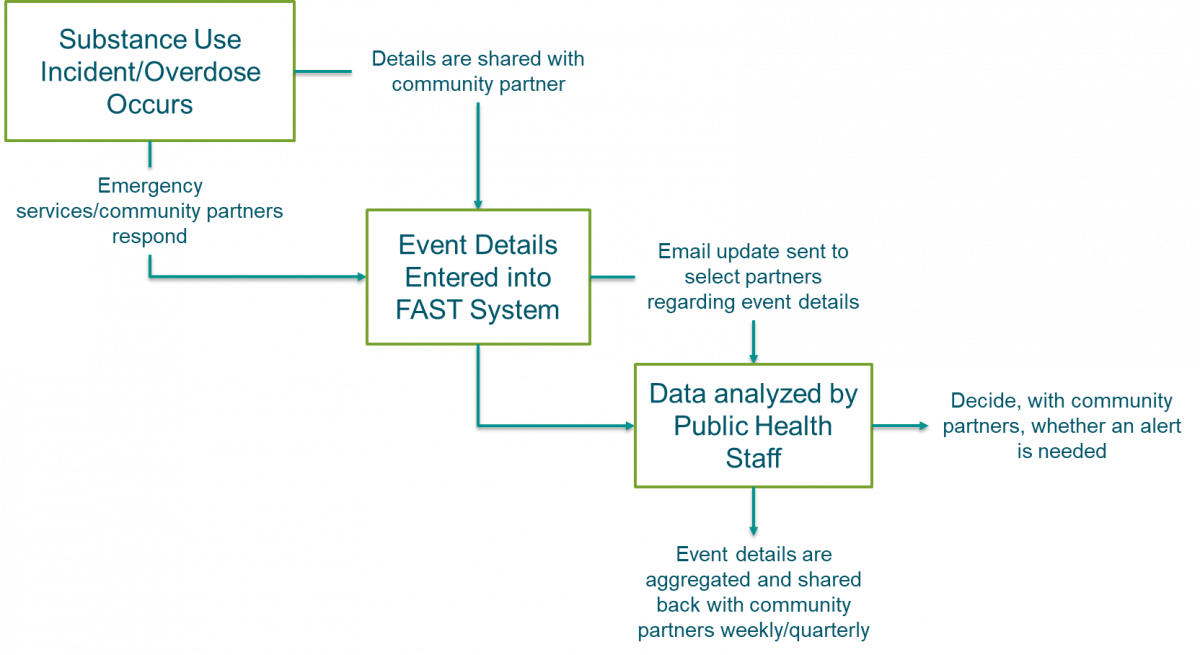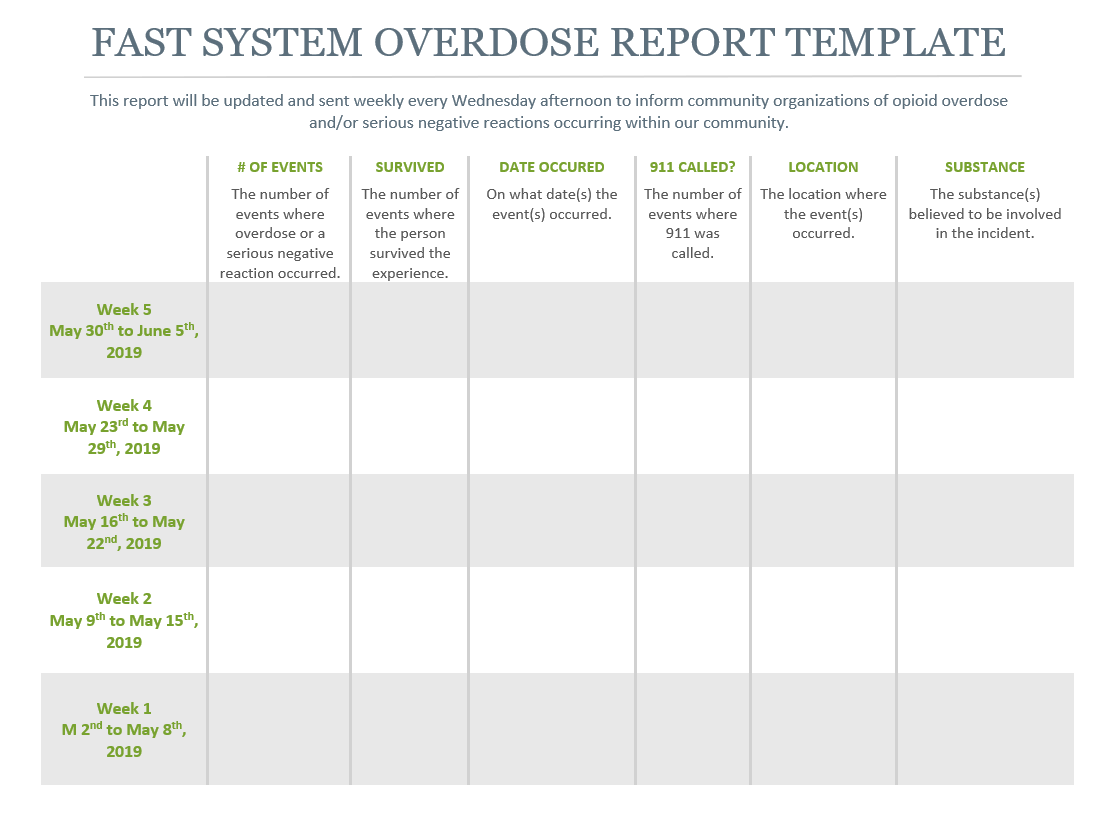For more information, please contact:
Health Analytics
Wellington-Dufferin-Guelph Public Health
160 Chancellors Way
Guelph, ON N1G 0E1
T: 519-822-2715 or 1-800-265-7293
Terms of Use
This guide and platform may be republished, modified and/or reproduced for non-commercial use in any form with acknowledgement to Wellington-Dufferin-Guelph Public Health.
Table of Contents
Introduction
Purpose
System Overview
Resources
Community Engagement
Data Flow Diagram
Planning and implementation steps
Resources
Agenda Samples
Email templates
Online Reporting Form
Weekly Report Template
Quarterly Report
Substance Use Alert Template
Conclusion
Introduction
The FAST (Flexible, Scalable, Accessible, and Timely) Overdose Alert Platform collects real-time information on substance-related overdoses and incidents from local service providers to build a detailed understanding of local patterns and trends. This system is designed to provide community organizations with timely information about overdose patterns in their communities. Benefits also include the ability to respond quickly and appropriately to contaminated substances and abnormal overdose patterns through Health Alerts, and a strong network of organizations committed to addressing substance use. This system has been recognized nationally as a winner of the MaRS Discovery District Opioid Data Challenge.
The FAST Overdose Alert Platform leverages the experience and knowledge of community organizations connecting with people who use substances. It is currently being implemented across the Yukon and in several cities and towns throughout Canada, The FAST Overdose Alert Platform is customizable to the diverse needs of each community.
There are several benefits for using this system in conjunction with other data sources:
- Real-time data collection results in a much timelier understanding of local overdose patterns, allowing communities to respond more quickly and appropriately to changes in drug supply.
- The Overdose Alert Platform allows for the collection of overdose information connected to incidents in which emergency services are not accessed.
- Alerts can be shared in response to the appearance of abnormal overdose patterns or the presence of strong/contaminated drug supply to inform community agencies, substance users, EMS and other stakeholders to respond quickly and appropriately.
- Through community involvement, overdose patterns can be discussed, shared and evaluated to ensure an accurate understanding of local patterns.
Purpose
This Resource Guide has been created to outline the design of the FAST Overdose Alert Platform for other health units, organizations and networks to use in their own communities. Because it was designed to track local overdose patterns and trends in real-time, community organizations and health agencies can better respond to community needs. This document will detail the technical specifications required to establish this system in your community.
System Overview
WDGPH faced challenges in determining a timely source of information for opioid-related overdose tracking and reporting. Surveillance systems such as the National Ambulatory Care Reporting System (NACRS) and the Discharge Abstract Database (DAD), available through the IntelliHEALTH database, supply high quality, meaningful data. However, these sources lack the timeliness needed for an early warning alert system when unusual overdose patterns occur in the community. Alert systems are needed to understand, and quickly respond to, the current climate of substance use harms.
Resources
The FAST Overdose Alert Platform utilizes software commonly available to health units and other service organizations. This results in a system that is accessible and flexible. You’ll need the following to implement the FAST Overdose Alert Platform:
1. A survey platform
A survey platform is needed for community partners to report on known substance use incidents/overdoses
2. One dedicated staff member
This team member is responsible for connecting with outside organizations and building the initial network needed for this system. This includes identifying organizations that work with people who use substances, finding connections through developed partner relationships and maintaining community relationships. Depending on the frequency decided with partners for reporting, this person will monitor, analyze and disseminate information about reported incidents.
3. Communications expertise (if possible)
A main deliverable of this system is the sharing of Health Alerts to warn community members of a contaminated or potent drug supply showing up in the community. Communications expertise can help design Health Alerts in a consistent manner with language that reaches the right audience with language and design features that create impact. Community partners can share the Health Alerts with individuals they are working with in the community and social media sharing will ensure that a Health Alert is received by those who use substances whether they are accessing a social service or not.
Community Engagement
Engaging community partners is the foundation of the FAST Overdose Alert Platform. Successful implementation of the Platform is based on this being a community-driven project. The online reporting form can easily be adapted to meet the differing needs of communities. Community partners are engaged in making important decisions about what fields should be included in the reporting form. In a facilitated session, partners identify local goals. Community assets and gaps in information are also identified by partners.
Planning and implementation steps
This section will outline the steps needed to implement the FAST Overdose Alert Platform in your community. Although these steps are numbered, this process can be followed in any way that best suits your process. Contained within some sections are suggested resources to aid in this process. They are available in the “Resources” section or click on the resource text to be brought to the corresponding section.
1. Engage stakeholders
Identify stakeholders that work in harm reduction and those that respond to overdoses. This list will vary in each community but may include:
- First responders (Police, Ambulance, Fire)
- Community Health Centres
- Public health agencies
- Harm reduction agencies
- Shelters
- Addiction treatment centres
- Counselling agencies
- Government agencies (e.g., municipal or county offices)
- Outreach services
- Public services such as libraries
- Boards of education
Contact stakeholders to share information about overdose alert systems including purpose and benefits. Ask about their level of interest and invite them to attend an initial meeting or teleconference to discuss further. In a follow-up email send the resources listed below.
Resources:
- Overdose alert system reporting form (sample)
- Overdose alert system weekly report (sample)
- Overdose alert system quarterly report (sample)
- Overdose alert system: Elevator Pitch
2. Facilitate an initial planning meeting (or teleconference)
Develop an agenda for the meeting.
Suggestions for agenda items include a discussion of:
- How the Overdose Alert Platform works
- The Health Alert process
- Stakeholder roles
- Overdose Reporting Form
- Health Alert dissemination process
Decide on a date, time and location for the meeting or teleconference.
Invite stakeholders to the meeting/teleconference
Resources:
- Email inviting stakeholders to an initial meeting (template)
- Agenda for initial meeting (sample)
- Overdose alert system reporting form (sample)
- Alert (sample)
3. Customize the Overdose Alert Platform tools and solicit feedback
Using the feedback provided at the initial meeting, revise and finalize the Overdose Alert Platform process including the Overdose Reporting Form and the Health Alert template so that they are customized to the needs of your community.
Send an email to your stakeholders summarizing decisions made at the initial meeting. Provide a link to the revised Overdose Reporting Form and attach the revised Health Alert template along with the Health Alert dissemination process. Ask stakeholders to review the tools and invite them to send further suggestions for improvement.
Resources:
- Email to stakeholders summarizing decisions made at the initial meeting
4. Finalize decisions about roles
Engage stakeholders in making final decisions about which partners will:
- Submit overdose reports to the Overdose Alert Platform
- Receive weekly and quarterly reports
- Be involved in decisions to issue alerts
5. Initiate reporting and send out first weekly report
Set a reporting start date and inform partners.
Send out the first weekly report. Invite partners to share with additional organizations and ask them to tell you if they would like to join as either a reporting organization or a receiving organization.
Resources:
- Overdose Alert Platform weekly report (sample)
- Email to determine which partners are interested in receiving weekly reports (template)
6. Make decisions about issuing alerts as needed
If there is any concern about patterns or trends, consult with identified partners and determine a need for a Health Alert.
7. Facilitate a review meeting
Invite partners to a meeting to ask them what they see as strengths of the Overdose Alert Platform and what enhancements could be incorporated. Ask partners for feedback on all components of the system including weekly & quarterly reports, how to more effectively respond to reported substance use harms, updating the survey with new questions and creating a framework to determine the environment needed for an alert to be issued.
Resources:
- Agenda for review meeting (sample)
Resources
Agenda Samples
Initial Meeting
Discussion of alert process
- Purpose / benefits
- Timelines for development of tool and process
- Community awareness/training on alert system reporting form
Stakeholders
- Identify partners that will submit reports of overdoses to the alert system
- Identify partners that will receive weekly and quarterly reports
Alert system reporting form
- fields to include (review and consider samples)
Alerts
- Criteria for issuing an alert
- Partners involved in a decision to issue an alert
- Format and key messaging of the alert (review and consider samples)
- Sharing of alerts (social media, bulletin boards, etc.)
Review Meeting
Weekly reports/Quarterly Reports
- Is the content / frequency of reports adequate?
- How they are being used?
- How can we use the information to improve overdose response?
- How to share the information more broadly?
Reporting organizations
- update and discuss other possible additions
Explore possible additional questions
- Does the current list of questions meet needs?
Alerts
- How often should alerts be issued? How long should they be out for?
- Is the current decision framework meeting our needs?
- Are any changes needed for the design of alerts?
Email templates
Email to invite partners to an initial meeting (attach an agenda and a sample alert)
Hi colleagues,
I’ve had recent conversations with some of you exploring the idea of implementing a system to monitor opioid overdoses so that, as a community, we can better respond to changes in patterns and trends and issue alerts when needed. I’m proposing that we meet on [DATE, TIME] at [LOCATION] to further discuss an alert system. I’ve attached an agenda. You are welcome to send additions to the agenda.
In preparation for our meeting [or teleconference] I’ve attached a sample alert and I’m providing a link to a sample alert system reporting form: [LINK].
Email template to summarize the meeting decisions; share the revised reporting form and ask for further feedback (attach minutes, and the revised alert template)
Hi colleagues,
Thanks for the great meeting today! I’ve attached the minutes of the meeting. Just to summarize we have decided that [INCLUDE INFORMATION ABOUT DECISIONS]. Our next steps are to [DESCRIBE NEXT STEPS].
I’ve made changes to the alert system reporting form and the alert template based on your input. Here’s the link to preview the revised alert system reporting form: [LINK]. Please send me any suggestions for further changes by the end of the day on [DATE].
Regards,
Email template to share the final version of the reporting form
Hi colleagues,
I’m following up on our last meeting about the alert system reporting form to collect information about incidents of overdoses or serious negative substance use reactions. Thank-you to all those who gave some feedback. The form has been finalized. Here is the link: LINK
Just to quickly summarize our discussion:
We are hoping that this will help us to more quickly find out, and share, information about new patterns of overdoses including possible local tainted drug supplies or counterfeit pharmaceuticals.
We are starting out by asking service providers from a small group of organizations to add information to the alert system reporting form (insert LINK here) when they are aware that an overdose or serious negative reaction has happened. Currently the participating organizations are:
- Partner 1
- Partner 2
- Etc.
The information we collect will be shared in three ways:
- Weekly reports of overdose / negative substance reactions. These will be shared with all of the organizations listed above and any additional organizations who have indicated an interest in receiving them. A sample report is attached. If you are interested in receiving these weekly reports, please reply to this email and ask to be included in the distribution list.
- Alerts. These will be issued based on identification of need by [list alert-decision partners]. All of the organizations contributing information to the survey (listed above) will be notified before the alert is shared widely within the community. We will encourage partner agencies to share alerts widely through established networks to ensure it reaches the members of our community who most at risk. Rather than issuing alerts based on thresholds (number of incidents) we will issue an alert when we have information that; a local drug supply is tainted, overdoses are affecting a new demographic, or counterfeit pharmaceuticals are in the market.
- Quarterly reports. The information will be compiled quarterly and shared with all partners who have indicated an interest in receiving them.
Email template to determine which partners are interested in receiving weekly reports
Hi [Key Partner],
Yesterday we distributed our first official weekly incident report. Thank you so much for your help in this project, we value your contribution and support.
I was hoping to connect with you to see if it would be possible to distribute the attached Incident Report to your membership. Please ask whether they would like to receive this message weekly. If they’re interested I can add their name and email to the distribution list, so we get that information out to those who need it most.
Regards,
Email template for Weekly report (attach weekly report)
Good afternoon colleagues,
Attached you’ll find our Substance Use Incident Report for Week 2. This week three incidents were reported. Two incidents occurred in our most recent week (Week 2) and one in Week 1.
As always, if you have any questions or comments, feel free to reply to this email.
Regards,
Email template to decide about issuing an alert (send to alert decision group)
Hi colleagues,
Since [DATE] we’ve had [#] reports of opioid overdoses. This is an unusually high number for our community. All individuals consumed blue/purple fentanyl. [NAME OF POLICE PARTNER], have the police seen/seized anything like this? We are recommending that an alert, similar to the version attached, be sent out by [NAME OF PARTNER]. We would need to update the poster with the current information. Please let us know your opinion about sending out an alert.
Thanks,
Online Reporting Form
The online reporting form consists of several questions that relate to substance use harms/overdose. This list was built in partnership with WDGPH’s community partners, to effectively meet the community needs within the boundaries of WDGPH. Reporting organizations use this list to record event details into the FAST System.
The entire list of questions is available to you for download (image below). It will be important to connect with key stakeholders in your own community to determine if the questions included will collect the information that you and your partners need. Access to a paper version of the form is available here.
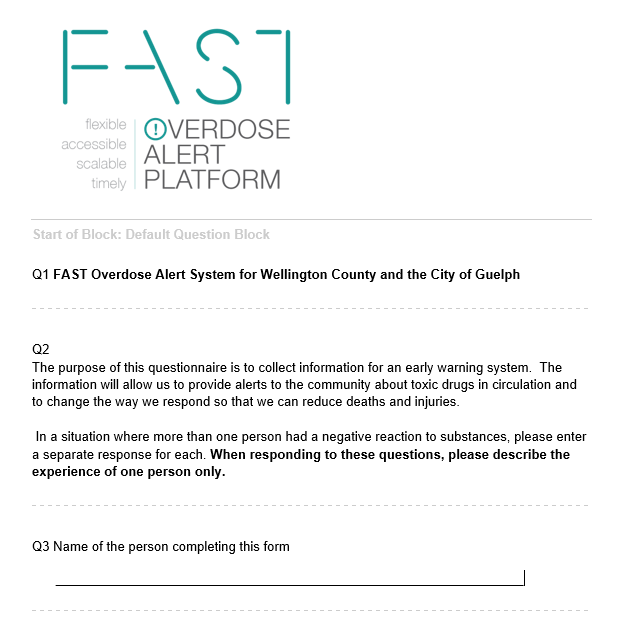
Weekly Report Template
The weekly report contains an aggregation of select details regarding the substance overdoses that occurred during the past week. The project lead is responsible for analyzing the data to ensure the removal of any duplicates, and to understand weekly trends. The week’s details are entered into the Weekly Report Template and shared with partners through email. Before sharing with partners, it’s a good idea to convert the document into PDF.
Quarterly Report
Below is an example of the FAST Quarterly Report. It was created using Power BI, a business intelligence program that allows a user to load, clean and visualize data in an interactive environment. This infrastructure does require a monetary investment to share reports with interactive capabilities, however those communities who do not have the resources to purchase the access to the sharing platform can use the desktop program for free. Quarterly reports can be easily saved as a PDF and shared in a similar manner as the weekly reports.
A free course is available on EdX.org for Power BI training that provides an overview of the program. The course can be accessed at this website.
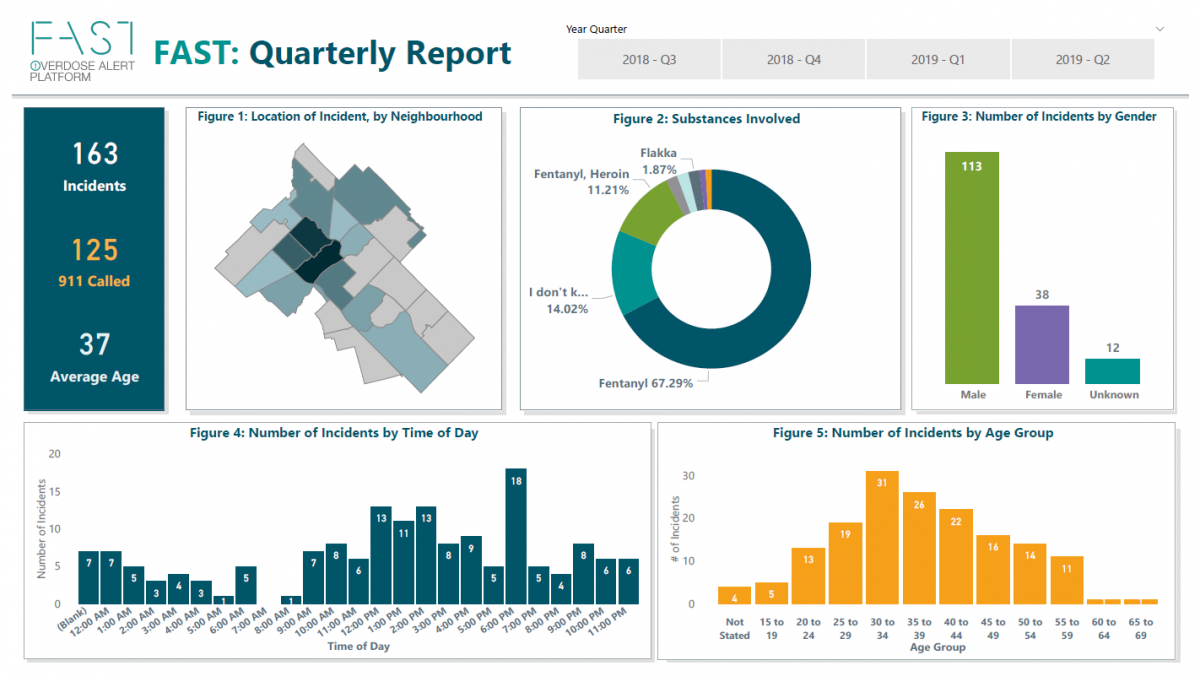
Substance Use Alert Template
Substance alerts are designed to be shared with the broader community to ensure that knowledge of substances that are contaminated/potent are shared with people with those who use drugs. An example of an alert is provided below.
Alerts are determined through consultation with several key organizations. Once an alert is confirmed and the appropriate messaging is decided, alerts in PDF and file types suitable for sharing through social media are distributed to organizations that receive the weekly alerts. Those organizations are then asked to share the alert on bulletin boards, through their social media channels and through word of mouth to their clients to ensure the message makes it to people who use drugs. Alerts are also shared with local media channels to broadcast to the broader community.
Below is an image of the alert template.
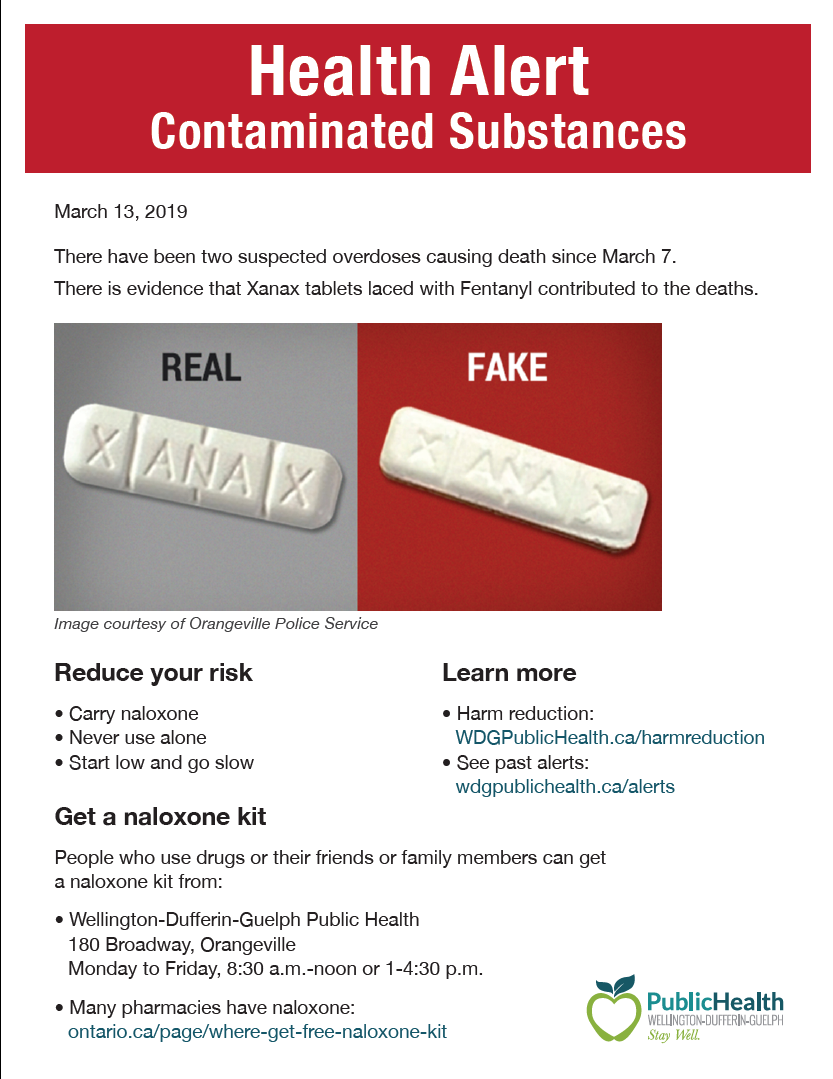
Conclusion
The FAST Overdose Alert Platform can be an effective tool for communities to understand local, real-time, patterns of overdose. The relationships created with community partners and organizations can provide a wealth of understanding and context in how it relates to these patterns. More timely responses are possible through substance use alerts and the mobilization of community partners/resources in order to prevent harms from substance use.

